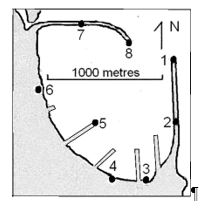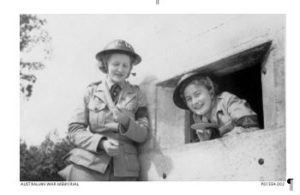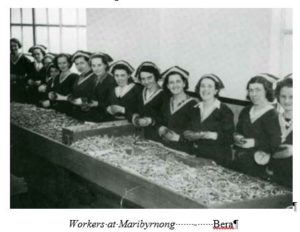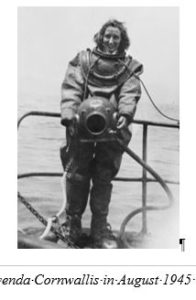- Author
- Turner, Mike
- Subjects
- History - WW2
- Tags
-
- RAN Ships
- HMAS Bungaree
- Publication
- September 2020 edition of the Naval Historical Review (all rights reserved)
By Mike Turner
During WWII many Australian women worked in new defence support roles. The mine warfare roles were manning Mine Watching Posts, manufacturing moored mines and manning the RAN Degaussing Range at Bradleys Head, Sydney.
WNEL volunteers at Mine Watching Posts
In August 1941 the RAN commenced planning a Mine Watching Organisation, there being a real concern that Japanese carrier–based aircraft could mine Australian ports using ground mines supplied by Germany (‘Ground’ mines were laid on the sea bed and most were actuated by a ship’s magnetic field). This organisation was intended to assist minesweeping and/or mine avoidance by providing a mine datum based on visual observation of mine entry into the water. German mines were normally laid with a large parachute to achieve a low velocity of impact with the water, and the splash on water entry was only about 8 m high. The Admiralty advised the Naval Board that the splash of a parachute mine should be visible for about 270 metres on a clear dark night, and sighting of the parachute itself depended largely on the background.
The form completed for a mine sighting included the true bearing obtained from an open sight and a bearing plate graduated with 5 degree divisions. Some observation posts were on ships and small craft, such as hired hopper barges, but most of the posts were around the shore line, preferably with a spacing of about 360 metres. Figure 1 shows the location of posts at Port Kembla, NSW.
In June 1942 a total of about 65 posts had been erected at Adelaide, Brisbane, Darwin, Melbourne, Port Kembla, Port Moresby, Sydney and Thursday Island. Posts were planned for Fremantle, Hobart, Newcastle, and Townsville.

A post was blast proof and bullet proof. It was about 1.8 m square, the minimum size for a prison cell. It was provided with a stretcher and was manned by two mine watchers, each keeping watch in turn during the hours of darkness.Training for mine watchers included Morse signalling by torch. At Brisbane there were 38 posts – three manned by the RAN, five manned by the US Army Air Corps (USAAC), five manned by Lytton Fortress Troops (LFT) and 25 manned by the Women’s National Emergency Legion (WNEL). Seventy posts were planned for Sydney – eight manned by the Army, 18 posts afloat by the Naval Auxiliary Patrol (NAP) and 44 by the WNEL.

The WNEL was formed in September 1938 to provide a variety of support tasks, such as first aid and truck driving. It was not part of the Australian military but cooperated with the Department of Defence. The headquarters were in Brisbane, the commandant being Major Helen Ryan, the founder of the WNEL. By April 1940 the WNEL had 4,000 members, including 1,600 in Brisbane. WNEL mine watchers wore an armband emblem which they bought at their own expense. Mine watchers proceeded directly from their place of employment to their post and rarely had time to go home before going to work. They were paid an allowance for each night on duty to meet out-of-pocket expenses incurred in tram fares and meals, however this allowance was not to be paid more than once per fortnight.
The threat of Japanese carrier-borne aircraft to Australia diminished after the Battle of Midway, and mine watching activities decreased after June 1942.
Mine production
HMAS Bungaree laid 8,696 Mk XIV moored mines made in Australia. The mines were manufactured by the Ford Motor Company at Geelong, VIC and 12,561 mines were produced between 1941 and 1944. The mine casing was two steel hemispheres of 1016 mm diameter welded to a cylindrical ‘belt’ 203 mm long. Women welded the hemispheres to the belt, and presumably made other components.
The main charge, normally 227 kg TNT, was manufactured by the Commonwealth Explosives Factory at Maribyrnong, Victoria and sent by road to the RAN Mine Depot at Swan Island, Victoria for insertion into the mine. Women made up half the workforce at this explosives factory, and there was the same proportion at nearby munitions and ordnance factories.
Occupational Health and Safety was not really considered in earlier times. Workers who handled TNT found that their skin turned bright yellow, and in World War I they acquired the nickname ‘canary girls’ or simply ‘canaries.’ Workers exposed to TNT suffered from violent headaches and nausea. Over a prolonged period they tended to experience anaemiaand. abnormal liver function. Explosions can occur at explosive factories even though there are rigid safety measures, an example being the explosion on 12 November 1996 at the ADI Munitions Factory at Mulwala, NSW.
WRANS at Bradleys Head Degaussing Range
Warships are fitted with degaussing coils to reduce the threat from magnetic mines. These coils generate magnetic fields that oppose ships’ magnetisation, and it is necessary to periodically check the coil settings since a ship’s magnetisation varies with time. For example, the ‘induced vertical magnetisation’ has opposite directions in the two hemispheres. Coil settings are checked by a ship passing over an array of magnetic sensors on the sea bed in a DG range. The RAN had several DG ranges, including one at Bradleys Head which was established by the USN and then operated by the Americans for a short period.

There were two sensor arrays at Bradleys Head, one for ships up to corvette size and the other for larger ships. The recording instruments were in a camouflaged two-storey timber building. The front overhung the water, so that out on the signal deck with its mast, flag locker, twelve- inch projector and telescope, and a bit of imagination, the similarity to a ship’s bridge was quite strong. A high barbed-wire-topped fence enclosed the building, the generator room and a small area of land on three sides of the installation.
The first WRANS arrived there on 9 December 1942, together with four Electrical Engineer Officers and one male V/S (Visual Signaller or ‘bunting tosser’) rating. The range initially operated on a daytime-only basis. When two V/S WRANS arrived on the scene some months later it came into continuous operation until it closed down.
There were three ‘day-duty only’ ratings – two WRAN writers, who coped with the secretarial and clerical duties, and one male rating who used to fall in for all the miscellaneous odd jobs. Duty was typical military FULL SPEED/STOP days without a ranging then a really hectic period when a convoy arrived in port, and it was a case of all hands on deck.

The live-in WRANS wore uniforms ashore, but their duty rig was ‘glamorous’ faded navy blue overalls (with everything crammed under them according to the weather) or equally attractive ‘Bombay bloomers’ and blouses. They kept their own kind of ‘watches’- 24 hours on, 24 hours off, with 48 hours on and off through the weekends. There were three WRANS to each 24-hour watch, one signaller and two instrument recorders (instrument recorders being in such small numbers they were in the Writers branch). Apart from operating the recorders they calibrated them and prepared DG coil setting charts for the intended areas of operation for vessels being ranged. They were a fairly versatile crew. The signallers taught the instrument panel operators to signal and they in turn taught signallers how to handle the instruments. This esprit de corps led signaller Gwenda Cornwallis to comment:
Co-operative efforts made for a very smooth-running organization and the total involvement in the range’s function, including the cooking and other domestic work that ‘living-in’ entailed, made our lives in the service of our country not only interesting but enjoyable. Yes, enjoyable! I, for one, loved it and I was not alone.

The live-in WRANS inherited the furniture, bedding, modern galley and all necessary utensils left behind by the Americans as Lend Lease. They were paid a victualling allowance and purchased all their own provisions at a shop in Rose Bay using a speedboat which was otherwise used by a range electrical officer to board a warship being ranged. When the speedboat was away for maintenance the range was provided with a 100 passenger Stannard’s ferry complete with its honky tonk piano.
Signaller Gwenda Cornwallis was ‘seconded’ to the RAN Diving School at Chowder Bay for a day and enjoyed a stroll along the harbour bed. Note: Gwenda (Southcombe) Cornwallis crossed the bar on 9 February 2019.
Bibliography
Bera, Igor, Maribyrnong Munitions and Explosive Factories during World War II <https://www.livingmuseum.org.au/student%20projects/…/index.htm?> (10 August 2018)
Gwenda Cornwallis in August 1945 – Australian War Memorial
Minewatching Organisation – Brisbane and Moreton Bay in Australia during World War II<https://www.ozatwar.com/ran/minewatchingbrisbane.htm> (4 August 2018) National Archives of Australia (NAA): MP 1049/5, 1924/4/594NAA: MP 1049/5, 1924/4/663
Notes by World War II WRANS Marie Brearley and Jean Nysen
Southcombe (Cornwallis) Gwenda, Home, Home on the Range (Degaussing) or Impressions and Confessions of a D.G. Bunting Tosser, Naval Historical Review, Vol 9, No 1, December 1988.
Toxology Principles for the Industrial Hygienist <https://books.google.com.au/books?isbn=1931504881> (10 August 2018)
TNT, <https://en.wikipedia.org/wiki/TNT> (10 August 2018)
Turner, Mike and Hector Donohue, Australian Minesweepers at War, Sea Power Centre, Canberra, Australia, 2018.
Women’s National Emergency Legion <https://en.wikipedia.org/wiki/Women%27s_National_Emergency_Legion> (5 August 2018)




